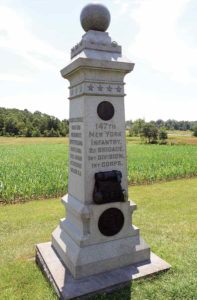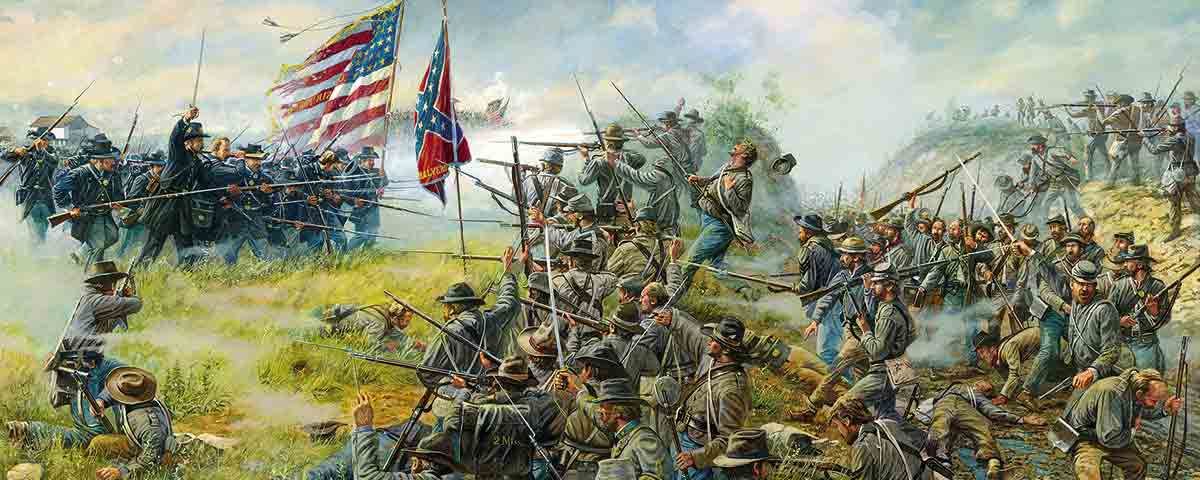If you’re at Gettysburg National Military Park and decide to trace the battle’s first-day action, you’ll more than likely come across a memorial to the 147th New York Infantry on Reynolds Avenue, just north of the Railroad Cut Bridge. It is, admittedly, a fairly standard monument: a bronze sculpture of a knapsack, canteen, and cartridge box perched below the regiment’s organizational legend. The inscription on the east side of the monument reads, “Position 10 A.M. July 1, 1863,” then lists the regiment’s strength and casualties. The strength and casualty figures are accurate, the position is not. The 147th as a regimental organization never formed where its monument stands.
The 147th was part of Brig. Gen. Lysander Cutler’s 2nd Brigade, 1st Division, 1st Corps—the first Union infantry brigade to reach the field the morning of July 1. But it arrived about 10:30, so the time inscribed on the monument is too early. Major General John Reynolds, the 1st Corps’ commander, was preparing to engage the advancing Confederates west of Gettysburg and needed to occupy McPherson’s Ridge before the enemy did. He split Cutler’s brigade, sending two regiments south of the Chambersburg Pike to occupy the ridge beside Edward McPherson’s farm buildings, while the other three regiments, including the 147th, were to move north of the pike and occupy the ridge near Captain James Hall’s 2nd Maine Battery, which had unlimbered opposite McPherson’s barn.
When Reynolds ordered those three regiments to support Hall’s battery, the 76th New York and 56th Pennsylvania moved as directed. For some reason, the orders never reached the 147th, so its commander, Lt. Col. Francis C. Miller, led the regiment along the low ground between the eastern and western branches of McPherson’s Ridge and massed it behind the barn for cover before riding off to get instructions. The confusion was quickly sorted out, and Miller returned to lead his regiment across the Railroad Cut and into a wheat field just to the north.
Meanwhile, the 76th New York and 56th Pennsylvania continued north behind the eastern ridge until they cleared the Railroad Cut, then turned left and advanced to the crest of the ridge, some 150–200 yards to the right and rear of the 147th. They immediately became engaged with the 2nd Mississippi and 55th North Carolina of Brig. Gen. Joseph Davis’ Brigade.
After the 147th advanced through the wheat, it came under fire from the 42nd Mississippi, also part of Davis’ Brigade. “I could see innumerable heads of rebels bobbing up and down on the north side of this wheat,” recalled Lieutenant J. Volney Pierce. “Men began to fall on all sides before we fired a shot.” The New Yorkers continued up the slope a short distance before being ordered by Miller to lie down and commence firing. “The battle was now in all its fierceness,” Pierce wrote. “[A] continuous roar of musketry drowned all orders.”

The 76th New York and 56th Pennsylvania were soon outflanked and ordered by Cutler to retreat toward Gettysburg. Miller received similar orders, but he would be wounded before he could deliver them to his men. The regiment, now under the command of Major George Harney, continued fighting, but it had become isolated—exposed on its right and rear as a Confederate contingent prepared to strike. To confront this new threat, Harney ordered his companies on the right to change front. The odds, though, were clearly not on his side.
Suddenly Captain T.E. Ellsworth, from the staff of division commander Brig. Gen. James Wadsworth, rode into the midst of the maelstrom and ordered Harney to fall back. The New Yorkers fled either across the Railroad Cut toward the McPherson Farm or along the cut itself. Nearly all of those who followed the cut, however, were quickly corralled and taken prisoner.
With 301 of the 380 men who engaged that morning killed, wounded, or captured, it had been a catastrophic 20 minutes of combat for the 147th,
That fall, when Gettysburg historian and artist John Bachelder published an isometric map of the battle, he mistakenly showed the 147th positioned on the same line as the 56th Pennsylvania and 76th New York. Fourteen years later, when Bachelder published separate maps for each day of the battle, he made the same error. The mistake, however, was an honest one, as a staff officer from Wadsworth’s staff had written him in 1865 that the three regiments had all been on one line when they became engaged. Then in 1868, Henry H. Lyman, the 147th’s adjutant during the battle, sent Bachelder a report of the regiment’s experiences at Gettysburg, noting they were “on left of 56th, 76th NY.” From these statements Bachelder assumed the 147th had begun fighting while on the same line as the other two regiments.
On July 1, 1888, the monument to the 147th was dedicated in its present position. Bachelder did not select the location, although the members of the Gettysburg Battlefield Memorial Association, working with veterans of the unit, likely used Bachelder’s maps. It is also possible the GBMA wanted the monument to be on the same line as the 56th Pennsylvania and 76th New York for ease of access for park visitors. Although most 147th veterans grudgingly accepted the erroneous position, Lyman led a concerted effort to set the record straight. Aware that Bachelder was writing an official history of the battle, the 147th veterans did not want it also to be incorrect. Lyman corresponded with more than a dozen officers and men, including one 2nd Mississippi officer, to document the regiment’s correct position, and forwarded what he learned to Bachelder.
His efforts paid off. On March 5, 1889, Bachelder wrote to Lyman that he had changed the narrative about the 147th’s location in his still unpublished history, thanking him “for establishing the truth.” Unfortunately Bachelder’s ponderous history is today read by only a handful of the most ardent Gettysburg students while hundreds of thousands of visitors drive by the regiment’s monument none the wiser that the men it represents actually fought and bled on the gentle rise about 200 yards to the west.
Scott Hartwig writes from the crossroads of Gettysburg, Pa.





